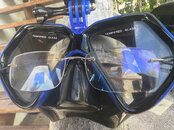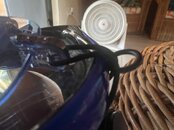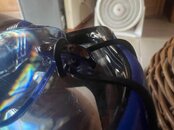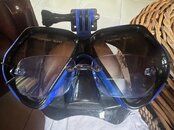SeaLionScuba1987
Registered
For the DIY types or if you have an odd prescription, astigmatism or other issue that precludes the available premade myopic/presbiopic lenses, or if they are not available in your area (or rather pricey) here is an easy way to make use of an old pair of glasses you’ve been keeping for emergency spares and keep that perfect-fit mask.
Forget stick-on lenses. They don’t work well.
Remove earpieces. With frameless or metal frames carefully bend the hinge around to create a hook OR replace the hinge screw to trap the o-ring in place. Plastic frames may need to cut off the hinge and a small hole drilled to secure the o-ring.
The o-rings I used were for the regulator 1st stage body, thin and maybe 1.25” diameter. Wet the hole with dish soap. Pass a fishing line through the hole drilled in the plastic glasses frame to loop through the o-ring & thread back through the hole. Pull the fishing line to pass the o-ring through the hole, loop over other side of o-ring to secure. Repeat for other end of frame. No need if metal frames can be bent into a hook.
Unlock mask strap or unthread one side. Soap may help here too.
Loop both o-rings around mask strap to orient properly with lens positioning in front of mask lens, moving o-rings around frame mount or connection point with skirt. Reattach or thread mask strap.
The o-rings should be slightly stretched to keep the lenses snugly positioned. Move them to sit over the lower portion of the view area as bifocals. If you use multifocal lenses the focus area should match your eye position when naturally reading. Look above lenses for distance vision.
NOTES:
Forget stick-on lenses. They don’t work well.
Remove earpieces. With frameless or metal frames carefully bend the hinge around to create a hook OR replace the hinge screw to trap the o-ring in place. Plastic frames may need to cut off the hinge and a small hole drilled to secure the o-ring.
The o-rings I used were for the regulator 1st stage body, thin and maybe 1.25” diameter. Wet the hole with dish soap. Pass a fishing line through the hole drilled in the plastic glasses frame to loop through the o-ring & thread back through the hole. Pull the fishing line to pass the o-ring through the hole, loop over other side of o-ring to secure. Repeat for other end of frame. No need if metal frames can be bent into a hook.
Unlock mask strap or unthread one side. Soap may help here too.
Loop both o-rings around mask strap to orient properly with lens positioning in front of mask lens, moving o-rings around frame mount or connection point with skirt. Reattach or thread mask strap.
The o-rings should be slightly stretched to keep the lenses snugly positioned. Move them to sit over the lower portion of the view area as bifocals. If you use multifocal lenses the focus area should match your eye position when naturally reading. Look above lenses for distance vision.
NOTES:
- This should work with ANY mask and glasses.
- Since the lenses are on the outside of the mask they will never fog.
- BUT because of water between script lenses & mask lens the strength of the priscription may no longer be an exact match. The less water gap the better.
- If using + lenses for camera icons, settings, gauge reading you may need to have different strength than you normally use for reading above water. Test different strength lenses until you can tell when photo subject is in perfect focus & settings can be read clearly.
- Rinse carefully after diving.
- Keep a spare o-ring in your camera bag.









